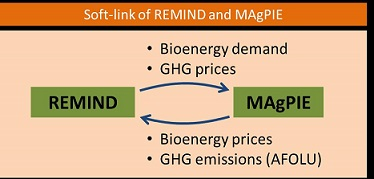Land-use - REMIND-MAgPIE: Difference between revisions
m (Mathijs Harmsen moved page Land-use - REMIND to Land-use - REMIND-MAgPIE without leaving a redirect: Text replacement - "REMIND" to "REMIND-MAgPIE") |
m (Text replacement - "REMIND" to "REMIND-MAgPIE") |
||
| Line 1: | Line 1: | ||
{{ModelDocumentationTemplate | {{ModelDocumentationTemplate | ||
|IsEmpty=No | |IsEmpty=No | ||
|IsDocumentationOf=REMIND | |IsDocumentationOf=REMIND-MAgPIE | ||
|DocumentationCategory=Land-use | |DocumentationCategory=Land-use | ||
}} | }} | ||
There are a number of important interactions of the energy, economy and climate systems represented in REMIND with the land system, such as emissions from land use changes and agriculture, or bioenergy supply. In the default standalone mode, REMIND relies on reduced-form approaches to account for these inter-linkages between the energy and the agricultural and land-use sectors (stand-alone mode). These are derived based on the state-of-the-art land use model MAgPIE <ref>Lotze-Campen H, Müller C, Bondeau A, et al (2008) Global food demand, productivity growth, and the scarcity of land and water resources: a spatially explicit mathematical programming approach. Agricultural Economics 39:325–338. doi: 10.1111/j.1574-0862.2008.00336.x</ref>; <ref>Popp A, Lotze-Campen H, Bodirsky B (2010) Food consumption, diet shifts and associated non-CO2 greenhouse gases from agricultural production. Global Environmental Change 20:451–462. doi: 10.1016/j.gloenvcha.2010.02.001</ref>; <ref>Lotze-Campen H, Popp A, Beringer T, et al (2010) Scenarios of global bioenergy production: The trade-offs between agricultural expansion, intensification and trade. Ecological Modelling 221:2188–2196. doi: 10.1016/j.ecolmodel.2009.10.002</ref>. For a detailed and fully consistent analysis of the integrated energy-economy-land use system, REMIND can also be soft-linked and run iteratively with MAgPIE as depicted in Figure 7 (coupled mode). The soft-link between REMIND and MAgPIE focuses on two crucial interactions: (i) bioenergy demand and supply, (ii) land use/land use change emissions and GHG prices. At the end-point of the iterative solution process, the markets for bioenergy and emission mitigation across the energy and land-use sector are in equilibrium. | There are a number of important interactions of the energy, economy and climate systems represented in REMIND-MAgPIE with the land system, such as emissions from land use changes and agriculture, or bioenergy supply. In the default standalone mode, REMIND-MAgPIE relies on reduced-form approaches to account for these inter-linkages between the energy and the agricultural and land-use sectors (stand-alone mode). These are derived based on the state-of-the-art land use model MAgPIE <ref>Lotze-Campen H, Müller C, Bondeau A, et al (2008) Global food demand, productivity growth, and the scarcity of land and water resources: a spatially explicit mathematical programming approach. Agricultural Economics 39:325–338. doi: 10.1111/j.1574-0862.2008.00336.x</ref>; <ref>Popp A, Lotze-Campen H, Bodirsky B (2010) Food consumption, diet shifts and associated non-CO2 greenhouse gases from agricultural production. Global Environmental Change 20:451–462. doi: 10.1016/j.gloenvcha.2010.02.001</ref>; <ref>Lotze-Campen H, Popp A, Beringer T, et al (2010) Scenarios of global bioenergy production: The trade-offs between agricultural expansion, intensification and trade. Ecological Modelling 221:2188–2196. doi: 10.1016/j.ecolmodel.2009.10.002</ref>. For a detailed and fully consistent analysis of the integrated energy-economy-land use system, REMIND-MAgPIE can also be soft-linked and run iteratively with MAgPIE as depicted in Figure 7 (coupled mode). The soft-link between REMIND-MAgPIE and MAgPIE focuses on two crucial interactions: (i) bioenergy demand and supply, (ii) land use/land use change emissions and GHG prices. At the end-point of the iterative solution process, the markets for bioenergy and emission mitigation across the energy and land-use sector are in equilibrium. | ||
<figure id="fig: | <figure id="fig:REMIND-MAgPIE_7"> | ||
[[File:54067656.png]] | [[File:54067656.png]] | ||
</figure> | </figure> | ||
'''Figure 1'''. In the coupled mode REMIND is soft-linked to the land-use model MAgPIE. The models are run iteratively and exchange information about bioenergy demand and supply and about emission mitigation in the land-use system. | '''Figure 1'''. In the coupled mode REMIND-MAgPIE is soft-linked to the land-use model MAgPIE. The models are run iteratively and exchange information about bioenergy demand and supply and about emission mitigation in the land-use system. | ||
Revision as of 14:34, 21 November 2021
| Corresponding documentation | |
|---|---|
| Previous versions | |
| Model information | |
| Model link | |
| Institution | Potsdam Institut für Klimafolgenforschung (PIK), Germany, https://www.pik-potsdam.de. |
| Solution concept | General equilibrium (closed economy)MAgPIE: partial equilibrium model of the agricultural sector; |
| Solution method | OptimizationMAgPIE: cost minimization; |
| Anticipation | |
There are a number of important interactions of the energy, economy and climate systems represented in REMIND-MAgPIE with the land system, such as emissions from land use changes and agriculture, or bioenergy supply. In the default standalone mode, REMIND-MAgPIE relies on reduced-form approaches to account for these inter-linkages between the energy and the agricultural and land-use sectors (stand-alone mode). These are derived based on the state-of-the-art land use model MAgPIE [1]; [2]; [3]. For a detailed and fully consistent analysis of the integrated energy-economy-land use system, REMIND-MAgPIE can also be soft-linked and run iteratively with MAgPIE as depicted in Figure 7 (coupled mode). The soft-link between REMIND-MAgPIE and MAgPIE focuses on two crucial interactions: (i) bioenergy demand and supply, (ii) land use/land use change emissions and GHG prices. At the end-point of the iterative solution process, the markets for bioenergy and emission mitigation across the energy and land-use sector are in equilibrium.
<figure id="fig:REMIND-MAgPIE_7">
 </figure>
</figure>
Figure 1. In the coupled mode REMIND-MAgPIE is soft-linked to the land-use model MAgPIE. The models are run iteratively and exchange information about bioenergy demand and supply and about emission mitigation in the land-use system.
- ↑ Lotze-Campen H, Müller C, Bondeau A, et al (2008) Global food demand, productivity growth, and the scarcity of land and water resources: a spatially explicit mathematical programming approach. Agricultural Economics 39:325–338. doi: 10.1111/j.1574-0862.2008.00336.x
- ↑ Popp A, Lotze-Campen H, Bodirsky B (2010) Food consumption, diet shifts and associated non-CO2 greenhouse gases from agricultural production. Global Environmental Change 20:451–462. doi: 10.1016/j.gloenvcha.2010.02.001
- ↑ Lotze-Campen H, Popp A, Beringer T, et al (2010) Scenarios of global bioenergy production: The trade-offs between agricultural expansion, intensification and trade. Ecological Modelling 221:2188–2196. doi: 10.1016/j.ecolmodel.2009.10.002